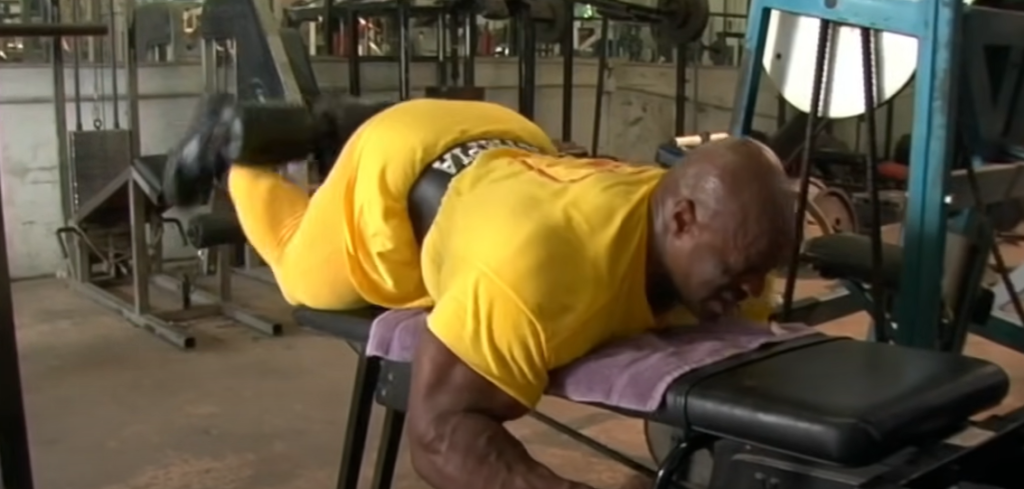Are you ready to take your workouts to the next level? Look no further than the ultimate fitness guru himself, pro bodybuilder Ronnie Coleman. With a workout routine that is bound to leave you both inspired and energized, Coleman’s tips are designed to help you push past your limits and achieve the body of your dreams. Whether you’re a seasoned gym-goer or just starting out on your fitness journey, incorporating Ronnie Coleman’s fitness tips into your routine is sure to amp up your workouts and deliver maximum results. So, grab your weights, put on your game face, and get ready to unleash your inner beast with Ronnie Coleman’s workout routine.
What is Bodybuilding?
Bodybuilding is a form of physical exercise that involves using resistance training to increase muscle size, strength, and definition for aesthetic purposes. It typically involves weightlifting exercises targeting specific muscle groups in order to develop a well-proportioned physique.
Bodybuilding is often associated with competitive bodybuilding, where individuals participate in bodybuilding competitions to showcase their muscular development. These competitions are judged based on symmetry, muscle mass, and overall physique.
Bodybuilding can be traced back to ancient Greece, where athletes would train using weights to enhance their physical abilities for sport events. However, the modern concept of bodybuilding dates back to the late 19th century when Eugen Sandow became known as the “Father of Modern Bodybuilding”.

Sandow’s approach to bodybuilding focused not only on strength but also on aesthetic appeal. He popularized posing and showcasing muscle definition, which became a significant aspect of competitive bodybuilding. Today, bodybuilding has evolved into a widely popular sport and recreational activity [1].
Types of Bodybuilding
There are several different types of bodybuilding that cater to different goals and preferences. Some of the most common types include:
- Bulking: This type of bodybuilding focuses on building muscle mass through heavy weightlifting and consuming excess calories to support muscle growth. It is typically done during the off-season for competitive bodybuilders.
- Cutting: Cutting, the process of reducing body fat while preserving muscle mass, is a key strategy to attain a lean and well-defined physique. It is typically employed by athletes and fitness enthusiasts before competitions or important photoshoots to showcase their hard-earned physique. This meticulous approach involves a combination of nutrition, exercise, and discipline to achieve the desired aesthetic goals. By carefully managing calorie intake, incorporating targeted workouts, and staying committed to the journey, individuals can sculpt their bodies and unveil the results of their dedicated efforts.
- Powerlifting: Powerlifting, a strength-based form of bodybuilding, incorporates three key lifts: the squat, bench press, and deadlift. Each exercise challenges athletes to lift maximal weight, pushing the limits of their strength and power. With a focus on compound movements and progressive overload, powerlifters continually strive to increase their performance and achieve new personal records. This demanding yet rewarding sport requires dedication, discipline, and a deep passion for pushing the boundaries of human strength.
- Natural bodybuilding:This type of bodybuilding, known as natural bodybuilding, emphasizes the development of a muscular physique through natural means, without relying on performance-enhancing drugs. By following a strict training regimen, maintaining a balanced diet, and utilizing techniques such as progressive overload, natural bodybuilders aim to build strength, increase muscle mass, and sculpt their bodies in a healthy and sustainable way. With a strong focus on discipline and dedication, natural bodybuilding promotes a holistic approach to physical fitness and showcases the incredible potential of the human body.
- Fitness/body sculpting: This form of bodybuilding, known as hybrid training, combines the benefits of both strength training and cardiovascular exercises. By incorporating a variety of resistance exercises and high-intensity interval training, it aims to sculpt the body, increase muscle strength, enhance endurance, and improve overall health and fitness. This comprehensive approach not only helps to build lean muscle mass but also boosts metabolism, promotes cardiovascular health, and increases functional strength and mobility. Whether your goal is to achieve a chiseled physique or maintain a healthy lifestyle, hybrid training offers a holistic approach to physical fitness.

Nutrition in Bodybuilding
Proper nutrition is not only crucial but also the foundation for achieving optimal results in bodybuilding. It goes beyond providing the necessary nutrients for muscle growth and recovery; it is about fueling your body with the right balance of macronutrients and micronutrients.
In addition to macronutrients, bodybuilders understand the significance of micronutrients in their diet. These include essential vitamins and minerals that play a vital role in overall health and well-being. Micronutrients support various bodily functions and also contribute to muscle building and recovery.
Bodybuilders often follow specific diets tailored to their goals. The high-protein diet is popular among bodybuilders as it provides the necessary amino acids for muscle repair and growth. The ketogenic diet, on the other hand, focuses on consuming high amounts of healthy fats, moderate protein, and very low carbohydrates to induce a state of ketosis, where the body utilizes fat as its primary fuel source.
It is important to note that creating a personalized meal plan for bodybuilding should be done in consultation with a professional nutritionist or trainer. They can help determine the optimal caloric intake, macronutrient ratios, and ensure that all nutrient needs are met to support your bodybuilding goals effectively.
Who is Ronnie Coleman?
Ronnie Coleman is a retired American professional bodybuilder. He was born on May 13, 1964 in Monroe, Louisiana and started his career as a police officer before transitioning into bodybuilding.
Coleman is widely regarded as one of the greatest bodybuilders of all time, winning the prestigious Mr. Olympia title eight consecutive times from 1998 to 2005. He also holds the record for most wins as an IFBB professional with 26 titles.
Growing up, Coleman had a passion for sports and was involved in various activities such as football, basketball, and track and field. It wasn’t until he attended Grambling State University on a football scholarship that he discovered his love for weightlifting and bodybuilding.

After graduating with a degree in accounting, Coleman became a police officer in Arlington, Texas while also pursuing his bodybuilding career on the side. He quickly rose through the ranks of the IFBB (International Federation of Bodybuilders) and won his first Mr. Olympia title in 1998.
Throughout his career, Coleman was known for his incredible mass and size, often being referred to as “The King” due to his dominant presence on stage. His rigorous training regimen and strict diet contributed to his success as he continuously pushed himself to new limits.
Despite facing numerous injuries throughout his career, including multiple surgeries on his back and hips, Coleman continued to compete at the highest level until his retirement in 2007. He then focused on his supplement company, Ronnie Coleman Signature Series, and became a motivational speaker and fitness influencer.
Today, Coleman’s legacy and impact on the bodybuilding world continue to be celebrated. He remains an inspiration to many aspiring bodybuilders and has left a lasting mark on the sport with his larger-than-life persona and incredible achievements.
Ronnie’s Training Principles
Frequency
In order to make progress and see results, it is important to have a consistent training schedule. This means working out at least three times per week, but ideally four or five days per week. Consistency is key when it comes to seeing improvements in strength, endurance, and overall fitness level.

Exercise Selection
When it comes to choosing exercises, Ronnie believes in the importance of compound movements. These are exercises that work multiple muscle groups at once, such as squats, deadlifts, and bench presses. Compound movements not only save time in the gym, but also allow for more functional and efficient training.
Progressive Overload
In order to continue making progress and avoid plateauing, it is important to constantly challenge your body by gradually increasing weight or reps over time. This concept, known as progressive overload, helps to stimulate muscle growth and strength gains. To implement this strategy effectively, Ronnie recommends keeping a log of your workouts and tracking your progress. By gradually increasing the weight or reps each week, you ensure a steady and continuous improvement in your fitness journey. This systematic approach not only keeps you motivated but also allows you to monitor your progress and make necessary adjustments to your training regimen. So, grab that notebook, set your goals, and embark on a journey of consistent improvement and growth!
Intensity
When it comes to exercising, intensity refers to the level of effort you exert during each workout session. To achieve progress and effectively challenge your body, it is crucial to gradually ramp up the intensity of your workouts as time goes on. This can be accomplished through various means such as increasing the weights you use, adding more repetitions or sets to your exercises, or even shortening the rest periods between different exercises. By continuously pushing yourself and making these adjustments, you can optimize your fitness journey and attain your desired results.
Heavy weights and low reps
Ronnie is a firm believer in the importance of lifting heavy weights with lower reps. This type of training focuses on building strength and muscle mass, rather than just endurance. It is important to gradually increase weight over time, while maintaining proper form to avoid injury.
Free weights over machines
While there are benefits to using both free weights and machines in your training, Ronnie emphasizes the importance of incorporating free weight exercises into your routine. Free weights allow for a greater range of motion and engage more muscles than machines do, leading to more functional strength.
Listen to your body
One of the most important principles in Ronnie’s training philosophy is listening to your body. This means paying attention to how you feel during workouts and adjusting accordingly. If an exercise feels too difficult or causes pain, it may be necessary to modify or switch to a different exercise. Always prioritize proper form and avoid pushing yourself beyond what your body can handle.

Train shoulders with multiple movements
Shoulder training is often overlooked, but Ronnie stresses the importance of incorporating multiple movements to effectively target all three heads of the shoulder muscle. This can include exercises such as shoulder press, lateral raises, and rear delt flys.
Rest and Recovery
In addition to consistent training, rest and recovery are crucial for seeing progress and avoiding injury. This includes getting enough sleep, staying hydrated, and taking rest days when needed. It is also important to incorporate stretching and foam rolling into your routine to prevent tightness and improve mobility [2].
Ronnie Coleman’s workout routine for you to follow
Upper Body Workout 1
In this routine, we will outline Ronnie Coleman’s upper body workout for you to follow. Ronnie Coleman is a legendary bodybuilder and has won the Mr. Olympia title 8 times. Follow his routine to build massive strength and size in your upper body.
Chest
- Bench Press: 3 sets of 10-12 reps
- Incline Bench Press: 3 sets of 10-12 reps
- Decline Bench Press: 3 sets of 10-12 reps
- Dumbbell Flyes: 3 sets of 12 reps
Back
- Deadlifts: 4 sets of 8 reps
- Pull-Ups/ Lat Pulldowns: 4 sets of12 reps
- Seated Rows: 3 sets of 12 reps
- One-Arm Dumbbell Rows: 3 sets of 10 reps each arm
Shoulders
- Military Press: 4 sets of 12 reps
- Side Lateral Raises: 3 sets of 12 reps each arm
- Rear Lateral Raises: 3 sets of 12 reps
Arms (Biceps and Triceps)
- Bicep Curls: 4 sets of 10 reps
- Hammer Curls: 3 sets of 10 reps each arm
- Tricep Pushdowns/Rope Pulldowns: 4 sets of12 reps
- Skull Crushers: 3 sets of 12 reps
Abs
- Crunches: 4 sets of 20 reps
- Russian Twists: 3 sets of 12 reps each side
- Planks: Hold for one minute, repeat for three sets.
Upper Body Workout 2
In this workout, we will continue with Ronnie Coleman’s upper body routine. This workout focuses on building strength and size in the chest, back, shoulders, and arms. Follow this routine to achieve a well-balanced upper body like Ronnie Coleman’s.
Chest
- Incline Bench Press: 3 sets of 10-12 reps
- Dumbbell Flyes: 3 sets of 12 reps
- Cable Crossovers: 3 sets of 12 reps

Back
- T-Bar Rows: 4 sets of 10 reps
- Bent Over Rows: 3 sets of 12 reps
- Close-Grip Pull Downs: 4 sets of 12 reps
- Single Arm Lat Pulldowns: 3 sets of 10 reps each arm
Shoulders
- Seated Military Press: 4 sets of 10 reps
- Dumbbell Side Lateral Raises: 3 sets of 12 reps
- Reverse Flyes: 3 sets of 12 reps
Arms (Biceps and Triceps)
Preacher Curls: 4 sets of 10 reps
- Concentration Curls: 3 sets of 12 reps each arm
- Tricep Dips: 4 sets of 12 reps
- Overhead Tricep Extensions: 3 sets of 10 reps
Abs
- Leg Raises: 4 sets of 20 reps
- Bicycle Crunches: 3 sets of 15 reps each side
- Side Planks: Hold for one minute, repeat for three sets.
Lower Body Workout 1
Ronnie Coleman’s lower body workouts are known for their intensity and focus on building mass and strength in the legs. Follow this workout to achieve powerful and muscular legs like Ronnie Coleman.
Quads
- Squats: 4 sets of 8 reps
- Leg Press: 3 sets of 10 reps
- Hack Squats: 3 sets of 12 reps
- Lunges: 3 sets of 10 reps each leg
Hamstrings
- Deadlifts: 4 sets of 8 reps
- Romanian Deadlifts: 3 sets of 10 reps
- Leg Curls: 4 sets of 12 reps
- Single Leg Deadlifts: 3 sets of 10 reps each leg
Calves
- Standing Calf Raises: 4 sets of 12 reps
- Seated Calf Raises: 3 sets of 15 reps
- Donkey Calf Raises: 3 sets of 12 reps
Lower Body Workout 2
In this workout, we will continue with Ronnie Coleman’s lower body routine. This workout incorporates different exercises to target all muscle groups in the lower body and build strength and size.
Quads
- Front Squats: 4 sets of 10 reps
- Leg Extensions: 3 sets of 12 reps
- Step-Ups: 3 sets of 10 reps each leg
- Bulgarian Split Squats: 3 sets of 12 reps each leg
Hamstrings
- Good Mornings: 4 sets of 8 reps
- Glute-Ham Raises: 3 sets of 10 reps
- Cable Pull Throughs: 3 sets of 12 reps
- Reverse Lunges: 3 sets of 10 reps each leg
Calves
- Standing Calf Raises (toes turned in): 4 sets of 12 reps
- Seated Calf Raises (toes turned out): 3 sets of 15 reps
- Leg Press Calf Raises: 3 sets of 12 reps [3]
Ronnie Coleman’s Diet
Ronnie Coleman’s diet is one of the most rigorous and extensive diets in the world of bodybuilding. Coleman, an eight-time Mr. Olympia champion, has become known for his incredible physique and strict dietary habits.
Coleman’s diet is based on a high protein intake combined with moderate amounts of healthy fats and carbohydrates. He typically consumes 6 meals per day, each consisting of lean meats such as chicken, fish, or turkey. These proteins are essential for building and maintaining muscle mass.
In addition to protein, Coleman also includes healthy fats in his diet. Sources such as avocado, nuts, and olive oil provide important nutrients and help keep his body fat levels low. Carbohydrates play a crucial role in Ronnie Coleman’s diet as well. However, he focuses mainly on complex carbohydrates such as sweet potatoes, brown rice, and oatmeal. These slow-digesting carbs help provide sustained energy throughout the day.
One of the unique aspects of Coleman’s diet is his use of supplements. He regularly takes protein powder, BCAAs (branched-chain amino acids), creatine, and glutamine to support muscle growth and recovery. To maintain his intense training schedule, Coleman also pays close attention to hydration and electrolyte balance. He consumes a gallon of water each day and includes sports drinks in his regimen to replenish electrolytes lost through sweat.
Despite being known for his strict dietary habits, Ronnie Coleman believes in balanced nutrition that includes occasional indulgences. He allows himself cheat meals once a week to satisfy cravings and prevent feelings of deprivation.
In addition to his diet, Coleman also follows a rigorous training routine and takes recovery and rest seriously. This combination of disciplined nutrition and intense training has helped him achieve incredible success in the bodybuilding world.
FAQ
How many times a day does Ronnie Coleman workout?
Ronnie Coleman is known for his intense and grueling workout routines. He has stated in various interviews that he used to workout 6 days a week, sometimes even twice a day. However, as he has retired from professional bodybuilding, it is unclear how often he works out currently.
What is Ronnie Coleman’s diet like?
Like most bodybuilders, Ronnie Coleman follows a strict and disciplined diet plan. His daily diet consists of lean proteins, complex carbohydrates, and healthy fats. He also consumes a lot of supplements such as protein shakes and vitamins to support his training.
What motivated Ronnie Coleman to become a bodybuilder?
Ronnie Coleman was always interested in sports and fitness since his childhood. However, it wasn’t until college when he saw a bodybuilding competition on TV that he became fascinated by the sport. He started training and competing in bodybuilding competitions, eventually becoming one of the most successful bodybuilders in history.
What are some of Ronnie Coleman’s achievements?
Ronnie Coleman has had an incredibly successful career as a professional bodybuilder. Some of his notable achievements include winning the Mr. Olympia title eight times, tying with Lee Haney for the most wins in the competition’s history. He also holds the record for most wins as an IFBB professional with 26 titles.
Did Ronnie Coleman do dips?
Yes, Ronnie Coleman did incorporate dips into his workout routine. Dips are an effective compound exercise that targets the chest, shoulders, and triceps muscles. As a professional bodybuilder, Ronnie Coleman focused on building strength and muscle mass in all areas of his body, so dips were certainly a part of his training regimen. Additionally, dips are a popular exercise among bodybuilders as they help to develop the upper body muscles and improve overall upper body strength. So it is no surprise that Ronnie Coleman included them in his workouts. It is important to note that each individual’s workout routine may differ based on their goals and preferences.
Useful Video: Ronnie Coleman 2003 Mr. Olympia Training | Part 1 | Ronnie Coleman
Conclusion Paragraph
So, Ronnie Coleman’s workout routine and diet strategy are unique in their own way. He has set an example for all bodybuilders to follow with his dedication and hard work towards achieving his goals. His workout routine may not be suitable for everyone, but it is definitely worth trying out. Ronnie Coleman’s diet plan is also something that should be taken into consideration by anyone looking to improve their physique. It showcases the importance of a well-balanced diet and the role it plays in achieving overall fitness. In conclusion, Ronnie Coleman’s success as a bodybuilder can serve as an inspiration for many individuals striving towards a fit and healthy lifestyle. Along with his training methods and dietary choices, his unwavering determination and discipline prove to be key factors in achieving one’s desired physique.
References:
- https://www.ironmaster.com/blog/what-is-bodybuilding/
- https://www.muscleandfitness.com/flexonline/training/10-training-tips-legendary-ronnie-coleman/
- https://jackedgorilla.com/ronnie-coleman-workout-routine/










Leave a Review